Far from the bustling tourism hotspot in Bali’s south is the city of Singaraja, the capital of Buleleng Regency on the island’s northern coast. Founded by the king of Buleleng, Ki Gusti Ngurah Panji Sakti, in 1604 on an empty grassland surrounded by buleleng – corn-like shrub widely planted by local residents at that time – the city, literally ‘Lion King’ after the indomitable ruler, gained prominence during Dutch colonial period on the island.
Following their successful campaigns using divide et impera (divide and rule) strategy to gain more control of regions across the Indonesian archipelago, in 1846 the Dutch eventually launched a military intervention to control Bali, still very much independent at that time but engulfed in conflicts among small kingdoms on the island.
But it was not until the third attempt in 1849 that the Dutch eventually defeated the Kingdom of Buleleng with the help of the Kingdom of Bangli, Buleleng’s long fierce rival, which almost six decades later was also subjugated by the European power when they gained full control of the island by 1908.
Following the conquest, Singaraja was chosen to be the seat of the Dutch colonial administration in Bali and the Lesser Sunda Islands – a group of islands what today consists of Lombok, Sumbawa, Sumba, Flores, West Timor and other smaller islands.
During the successive Dutch military campaigns a self-taught artist from Amsterdam by the name of Wijnand Otto Jan Nieuwenkamp visited Bali in 1904, the first ever European artist to visit the island. His fascination for the local culture and art sparked curiosity from other artists who would soon follow his footsteps and find their own way to the island.
His presence in the northern coast of Bali seems to leave a long-lasting impression to the locals who then immortalized the foreign artist in stone relief at Pura Meduwe Karang, a Hindu temple dedicated to Batara Meduwe Karang (God of the land). The small temple, 12 km east of Singaraja, was built to protect the soil and crops of the village of Kubutambahan, which more than a century after the Dutch artist’s visit are still as prolific as they have always been.
A more descriptive depiction on how life was like in the time of Dutch military campaigns is evident at Pura Dalem Jagaraga, 11 km east of Singaraja, where reliefs of Dutch military aircraft, soldiers, and a Ford Model T adorn the temple’s walls, alongside with portrayals of the island’s bucolic scenes during the tumultuous period.
However it was the temple’s caretaker, an elderly man with the smile and demeanor so radiant and warm, those of the people much younger than him, who was the highlight of our visit to the relatively unknown temple. He welcomed us with a big grin, alone on the temple grounds despite the fact that it coincided with the annual tourist surge flocking to Bali’s ever crowded south and beyond.
Speaking with a melodious Balinese accent, he explained to James and I in both Indonesian and English not only the history of the temple itself, but also the tenets of Balinese Hinduism – an eclectic concoction of Indian Hinduism, local traditions, and pre-Hindu beliefs.
When Bali was under the control of the Java-based Majapahit kingdom, the last major Hindu power in Java before the religion’s decline in the 16th century, the royal court of Majapahit instructed all village elders in its territory to build three temples in each community: Pura Desa (village temple), Pura Dalem (funerary temple), and Pura Segara (ocean temple), dedicated to Brahma, Shiva, and Vishnu respectively.
He eloquently explained about the aspects of ngaben – Balinese elaborate funerary ceremony, as well as the concept of Balinese deities which in many ways is similar to one in India except for the notion of a central supreme being called Sang Hyang Widhi Wasa or Acinthya from whom all gods take individual manifestation. He, too, elucidated Balinese take on reincarnation.
“Did you see the relief of a man eaten by a giant crocodile before you came in here?” he asked us with an inquisitive yet jovial tone.
The relief depicted karma, as the caretaker put it in words: what a person would become in his next life.
“There are seven levels of karma. What one does in his current life determines what he will become in his next life,” he paused and continued with an amusing explanation. “If he does good things in life, he will go up to the next level. But if he does bad things he will reincarnate as a mosquito.”
“It is everyone’s dream to reach the highest level. And when he has reached that, he will no longer reincarnate. He has achieved moksha,” the old gentleman explained to us about the state when someone has reached the heaven, or nirvana, liberated from the cycle of rebirth and death.
Then he moved to another topic: how to read a Balinese temple.
Pura – Balinese Hindu temple – is one of the most ornately decorated religious structures one can find in the archipelago, and Pura Dalem Jagaraga’s caretaker enlightened us with the macro- and microcosm aspects of a pura.
A candi bentar, or split gate, is a prominent feature in most temples usually located at the entrance to a temple compound. A symbol of yin and yang, good and evil, positive and negative, inspired by the story of the day Shiva broke a mountain in half with his power. Hence the almost identical right-angled twins.
Then the kori agung, a meticulously carved mountain-like divider separating the first and second courtyards in a typical three-part pura. Pura Dalem Jagaraga, however, only has two courtyards, exposing the kori agung to the direct surrounding of the temple.
By this time the amount of information on Balinese Hindu belief, culture, and architecture had far exceeded what I learned from my previous trips to places on the island, and started to overwhelm me.
The gentleman seemed to notice that, then retreated to a bale – a typical Balinese shaded pavilion – and unfolded two pieces of photocopied papers. One was written with the history of Pura Dalem Jagaraga, while the other was on Balinese concept of the nine directional elements and each corresponding deity, seven layers of the universe, the manifestations of Sang Hyang Widhi Wasa, and a swastika – a traditional symbol for Hinduism.
He handed the papers to us, with his name written at the right bottom: KT Suradnya. Later we found out, KT stood for Ketut, like Ketut the medicine man made famous by Elizabeth’s Gilbert bestselling book Eat, Pray, Love. Both has similar lighthearted attitude, and both helped enlighten their visitors to many aspects of the unique religion that has shaped the island’s landscapes, both natural and cultural, into a beauty as the world knows it.
Two kilometers from Pura Dalem Jagaraga another uncommon temple awaits to be explored. Made from pink sandstone, Pura Beji is a Subak temple for the village of Sangsit, a manifestation of Tri Hita Karana philosophy to keep the village’s fields fertile and well-irrigated. Dewi Sri, a pre-Hindu Javanese-Balinese fertility goddess is worshiped at the temple to ensure perpetual good harvests in the village.
As we jumped out of our car and walked towards the temple’s entrance, a strong, familiar scent filled the air, emanating from an open ground next to the temple. Cloves were drying in the sun, an essential ingredient to make kretek, a type of cigarette distinctively Indonesian known for its fragrance and rich blend of flavors.
We saw no one at the first courtyard, but the temple was clearly well-kept. No wild overgrown shrub, only the beautiful pink hue radiating from the temple’s kori agung and inner sanctums. As we ambled along the grass pathway two little girls were running around and laughing, their eyes fixated to us. Unlike the local girl I met at Besakih who was persistent in selling trinkets, the presence of the little girls at Pura Beji felt more of a curiosity from the locals of the people visiting their comparatively deserted temple. Their kind eyes spoke the unspeakable words.
We took photographs of the ornately carved structures, taking advantage from the absence of other visitors at the temple apart from a young couple, presumably Europeans.
The girls kept playing and laughing not far from us.
“She wants to put a flower on your ear,” our driver, Bli Komang, said to me. “But she is very shy.”
I smiled at her, and she smiled back, albeit timidly.
Pura Beji’s impressive and meticulously carved reliefs are surely a sight to behold. But it was here, far from the constantly pulsating south, did I find unspoiled Bali all culturally-inclined visitors dream of seeing, and could also be quite the same ambiance that enthralled W.O.J. Nieuwenkamp himself. That, however, is likely to change sooner or later as plan to build Bali’s second international airport – much needed to keep up with the ever-growing influx of visitors – was unveiled by the central government a while back.
But is more tourists what Bali really needs? Or is it a more sustainable way to keep up with the demand without sacrificing the island’s charm that Bali actually has to focus on? The upcoming decade certainly will be a critical time for the island and its people, for the future of the abode of gods lies in their hands.

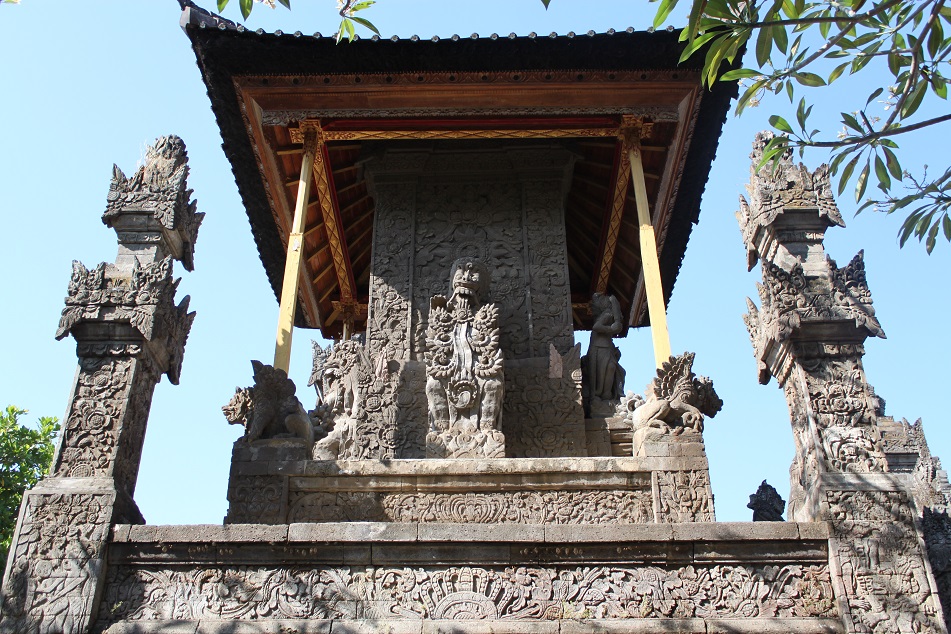
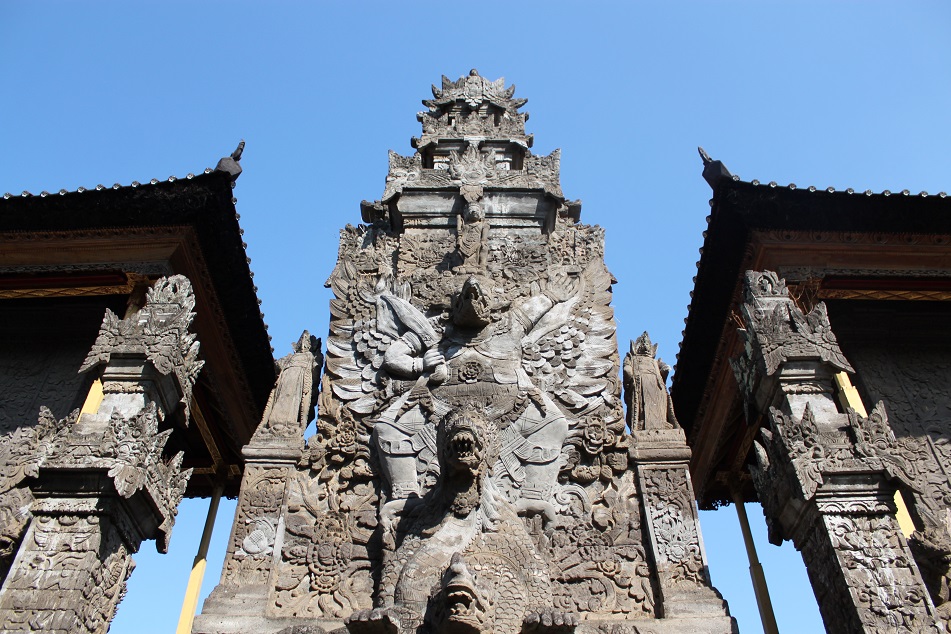

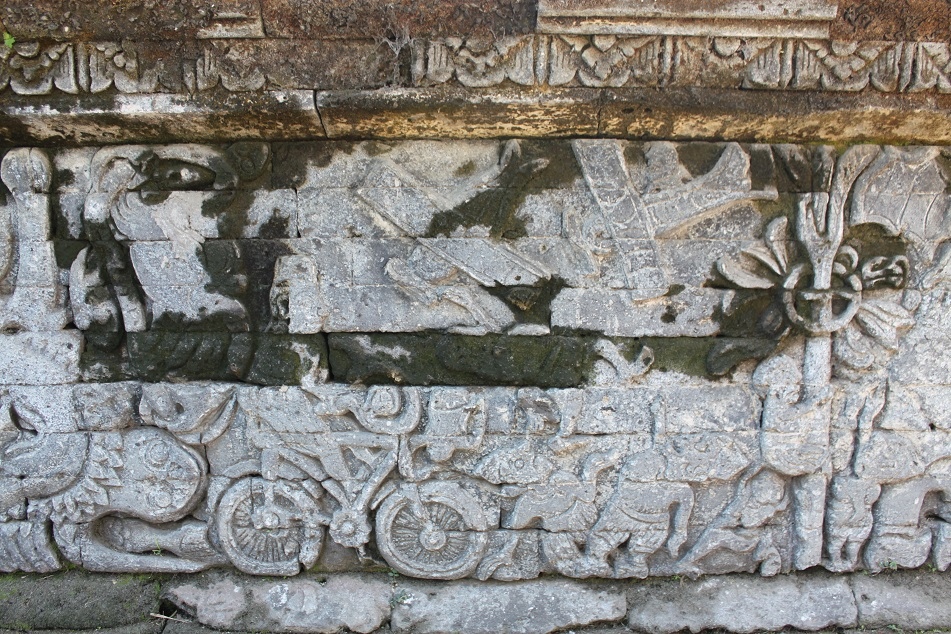
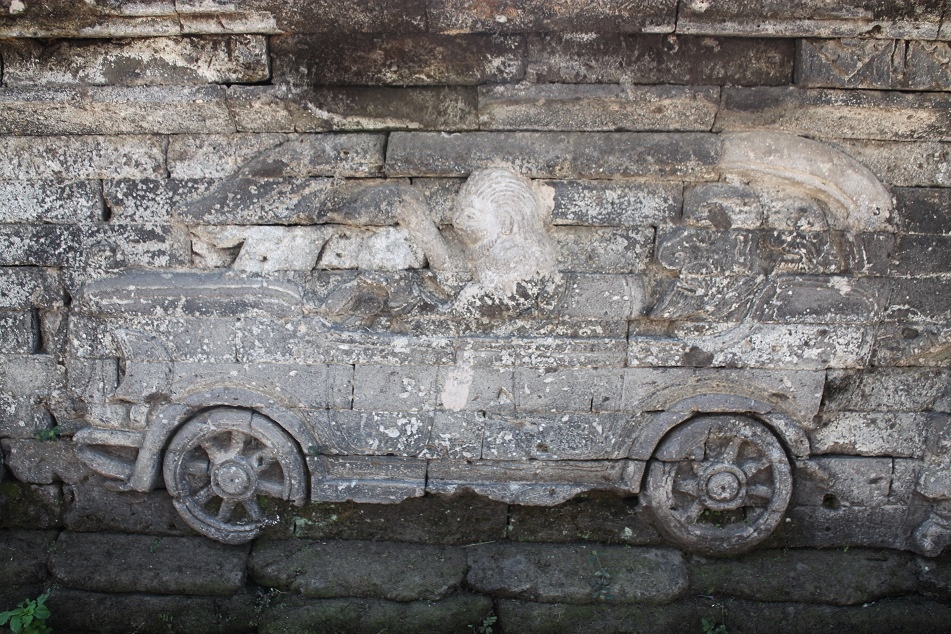
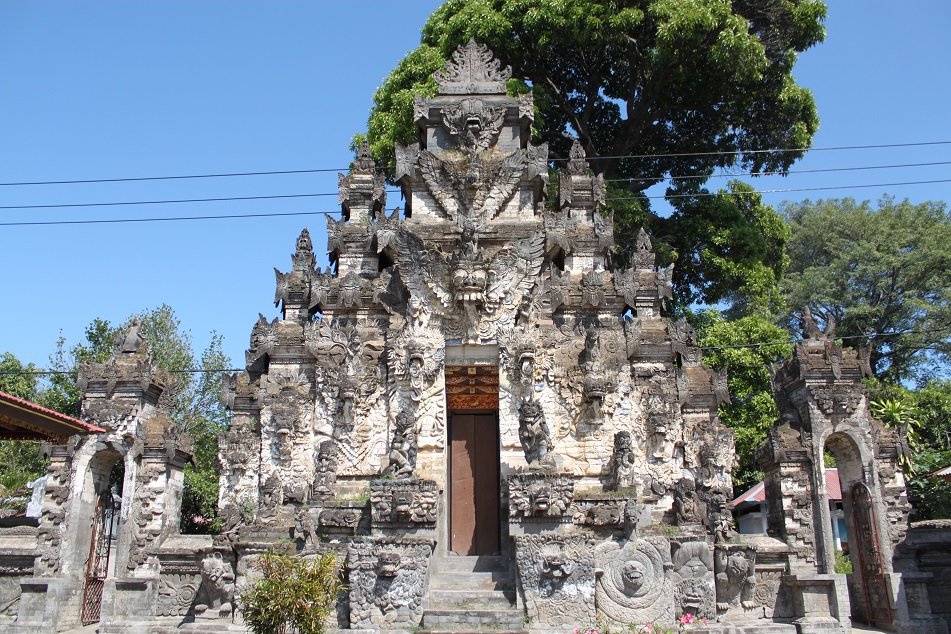
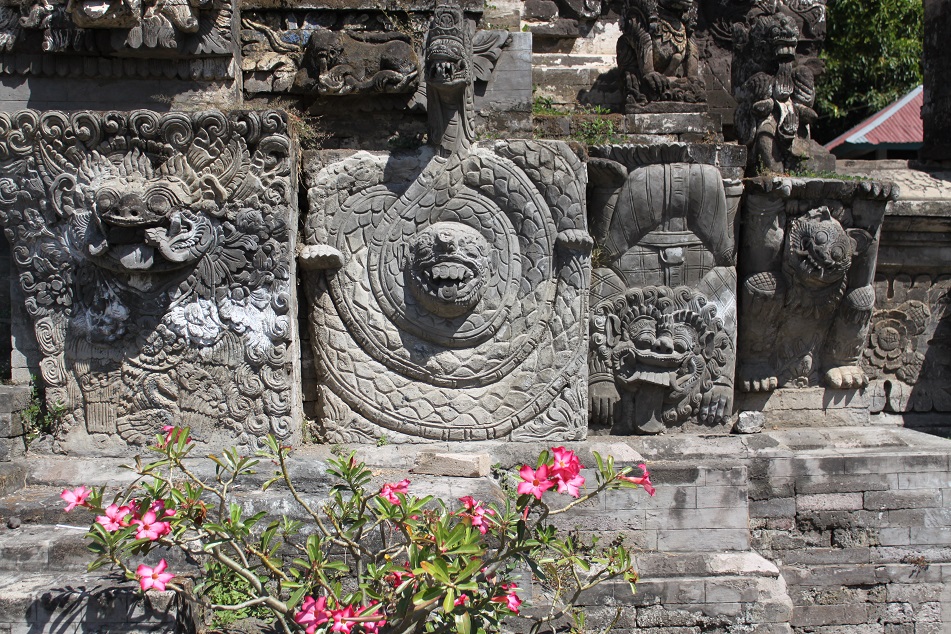
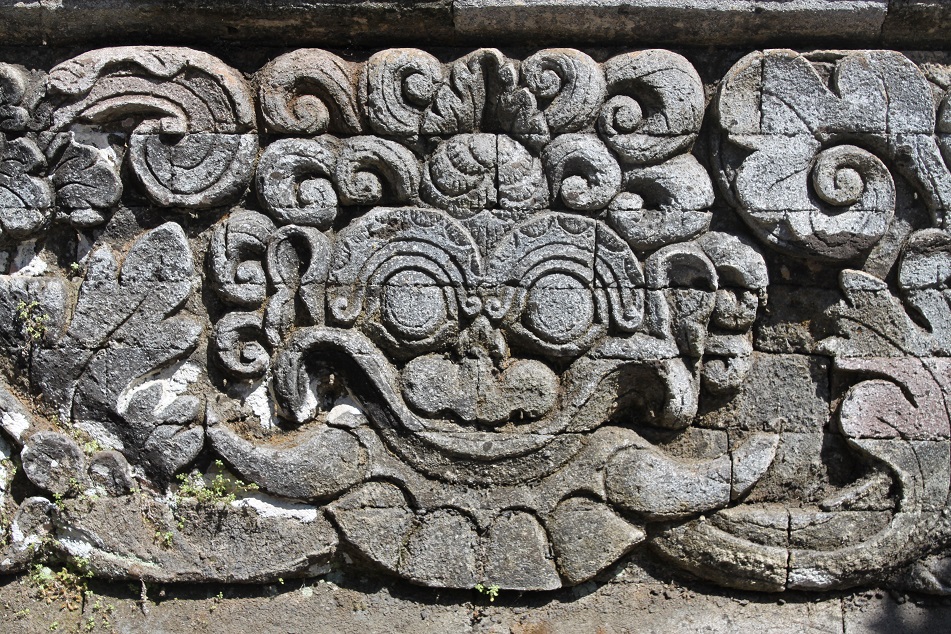
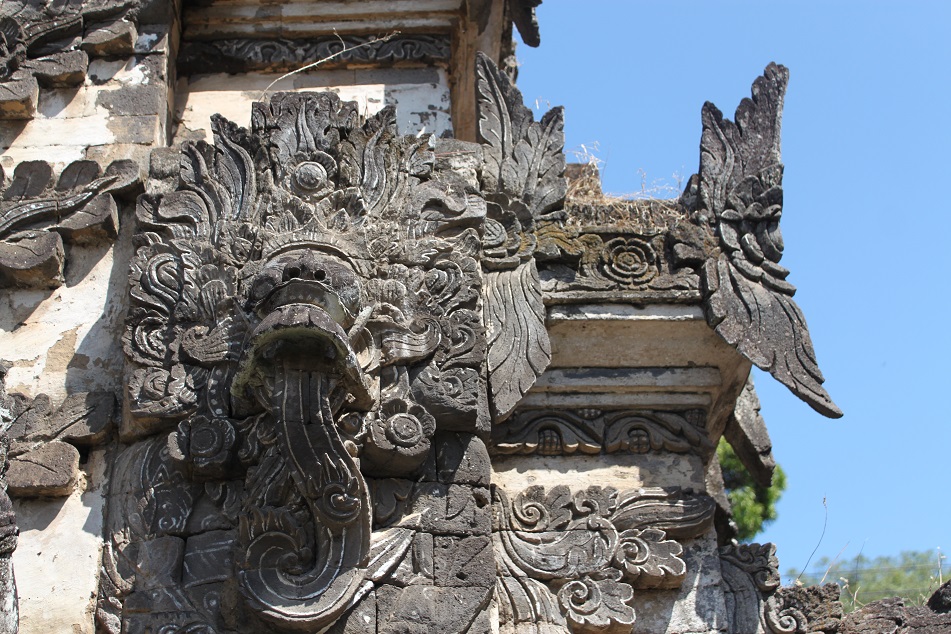
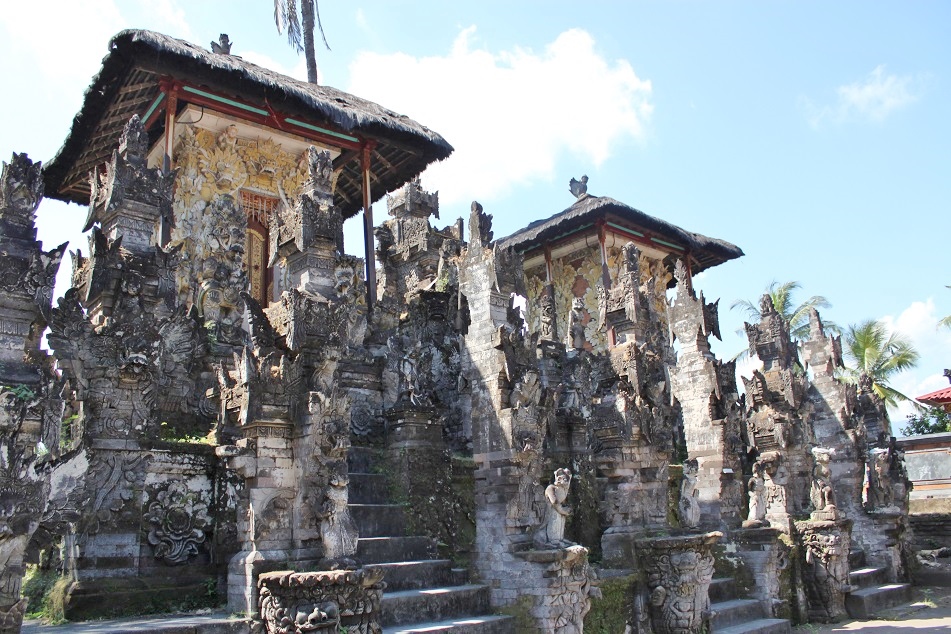
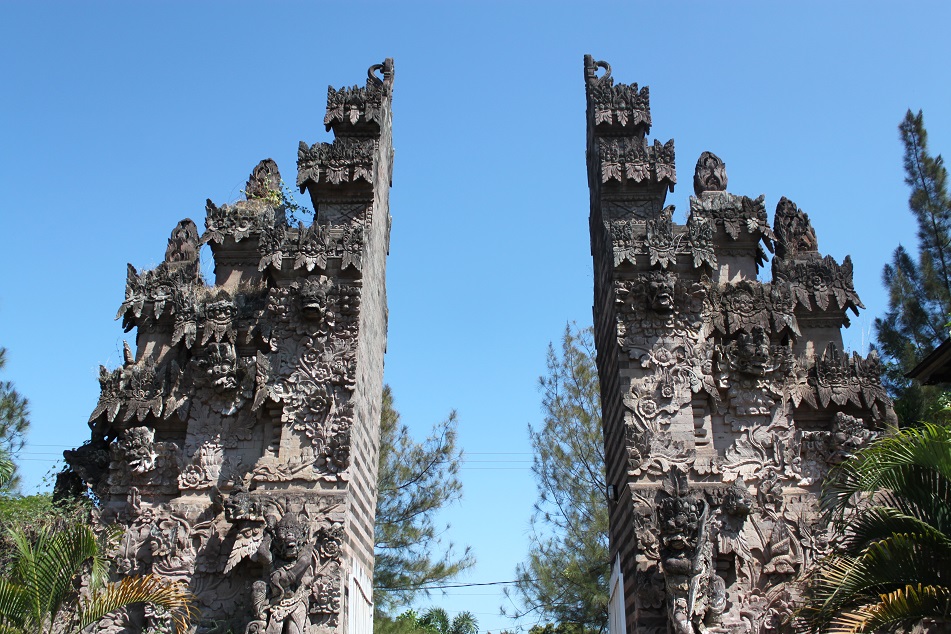
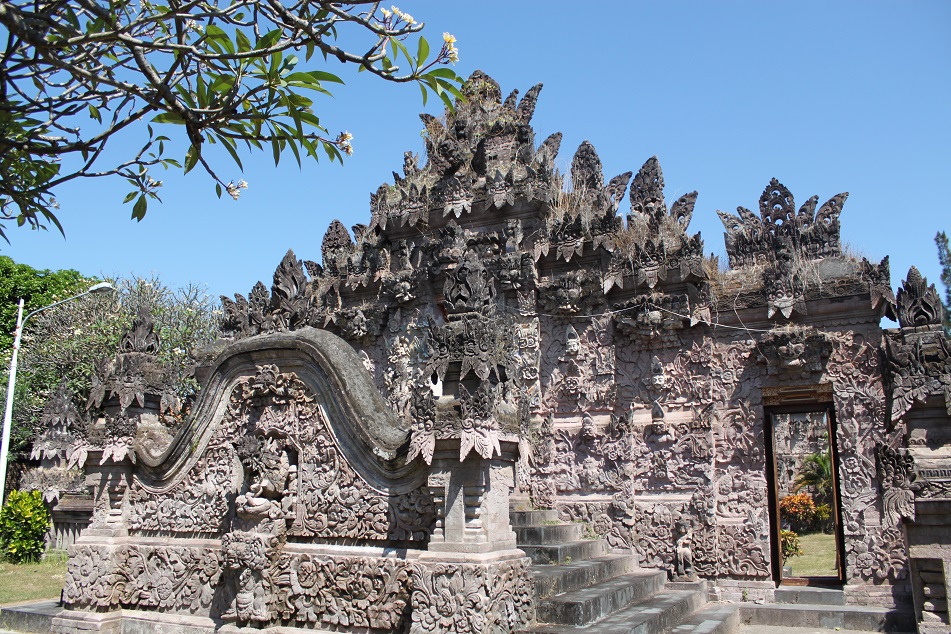

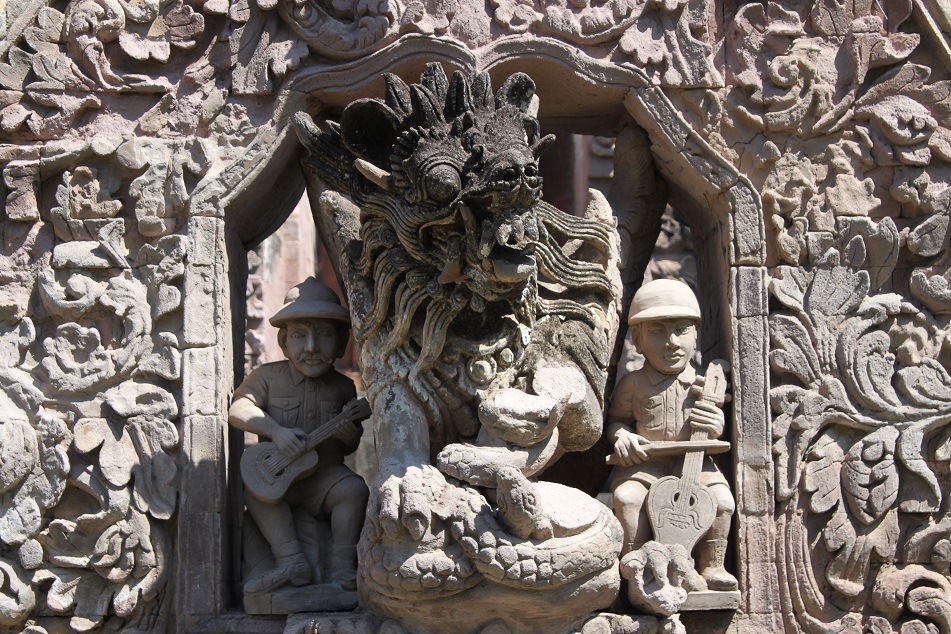
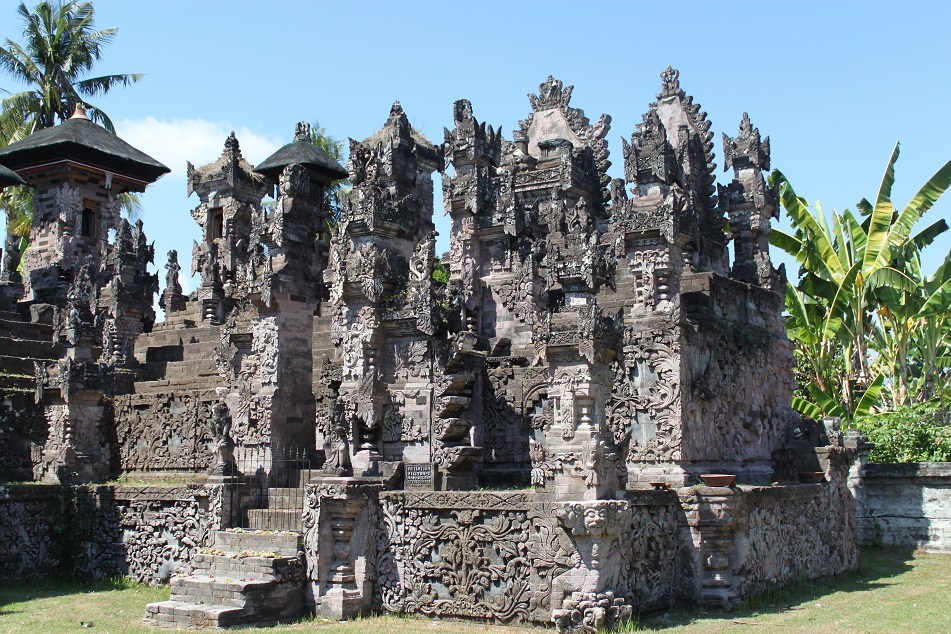
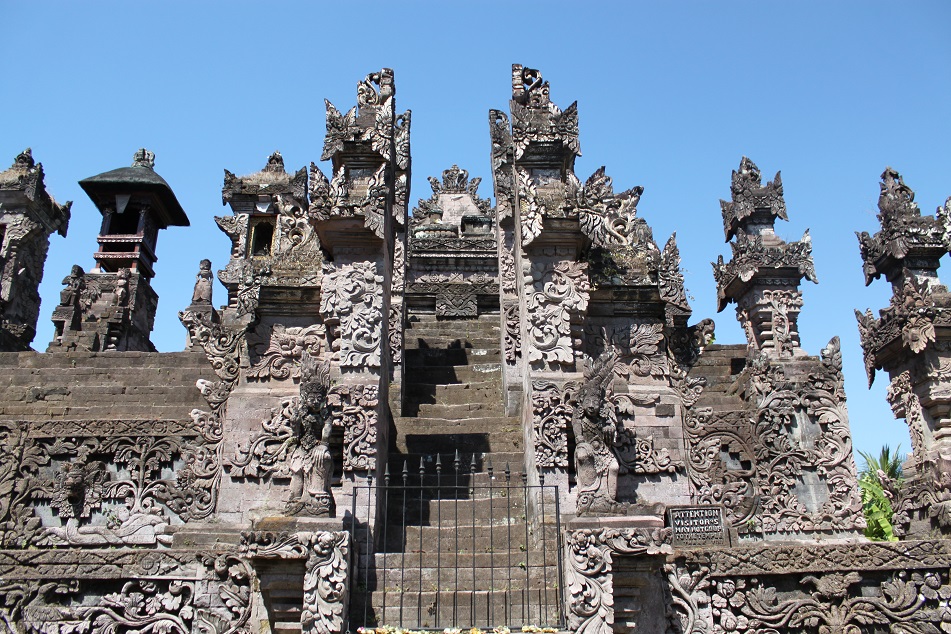
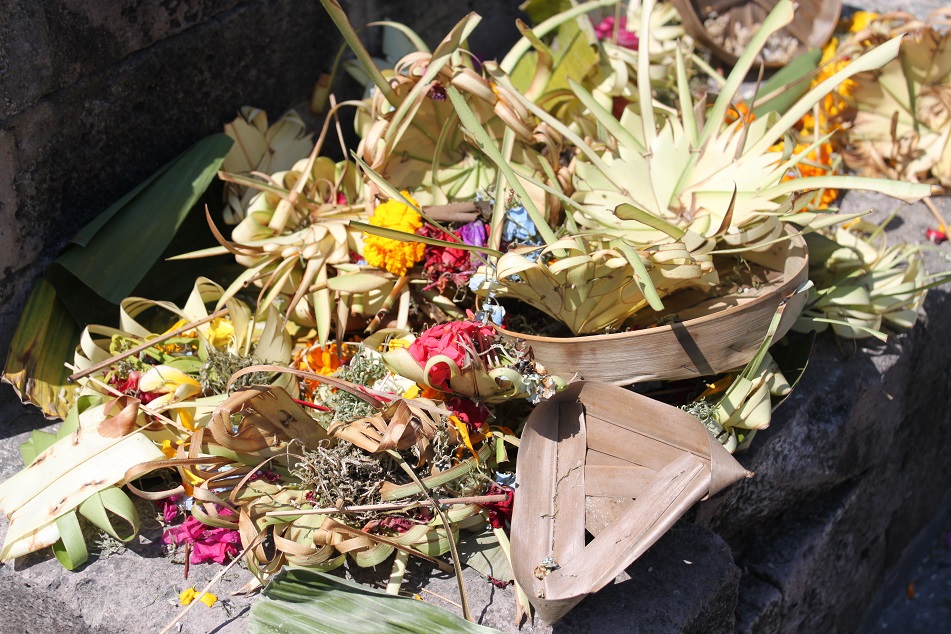
By the time you started to mention Pura Dalem Jagaraga, I guess you would come to my hometown village. And yes, you were.
Sangsit is my hometown, Mas. Oh, how happy I am to see you explained the temple next to my uncle’s house so comprehensively. My house itself is on the opposite side of the temple, before the parking lots.
The carvings of Northern Bali is quite different from the South, isn’t it? Northern’s style is dominated with more floral patterns, especially flower buds. Interestingly, the carvings on Northern Bali is quite similar with that of Eastern Java–again, with the flower buds, while Southern Bali’s carvings is quite different.
It’s interesting to know that Northern Bali’s temple consisted of a lot of small candi bentar, a characteristic that won’t be found on Southern Bali’s style. And actually, a more distinctive temple of Northern Bali just lies a few hundred meters from Pura Beji. It’s called Pura Pasupati, and you won’t find any Padmasana there.
So yes, we’re different, but it makes everything more beautiful, isn’t it?
Sangsit, Jagaraga, Buleleng, and Dutch share long, long history. The Tawan Karang Law–the law that started it all–actually first applied to Dutch’s ship at the very place of Sangsit’s harbor. That’s where all the wars were started–and about Jagaraga, we Sangsit people should say sorry, because it was Sangsit’s people who helped the Dutch so they could destroyed the fort of Jagaraga.
Ah, I think I should come home to Bali next time :)).
LikeLiked by 1 person
Wow Gara, I would have never guessed that you’re actually from Sangsit. Had I known that I would have asked you about other places to see in your hometown. 🙂
The carvings at the temples in northern Bali are obviously quite different from what I saw in other temples at the southern part of the island. As you said, floral patterns dominate all the three temples that I visited, more palpably at Pura Beji and Pura Meduwe Karang. The caretaker at Pura Dalem Jagaraga also told me that there was no elephant carvings at any temple in northern Bali.
It’s regrettable to know that the residents of Sangsit helped the Dutch defeat Jagaraga. But that was a past event, what’s important now is that the people from both villages work together to ensure this part of Bali remain as charming as it has always been.
Thank you for your explanation, Gara, and yes, I think you really should come home to Bali soon. 🙂
LikeLiked by 1 person
wow nice written article! Hi I’m Gab, an 18 year old travel blogger hope you check out my blog as well. http://www.travelerse.wordpress.com Thanks so much!
LikeLiked by 1 person
Hi Gab. Thanks for reading. You took some really nice photos!
LikeLike
Thank you for sharing this beautiful article and the inside of the Dutch history in Bali. I have been to Indonesia several times, and heard about this bike designs in the temples but never got to see them myself. Thank you for the sharing these beautiful pictures!
LikeLike
Thank you for reading and for your kind words! Getting to the temple from the airport takes around 5 hours, so it’s understandable why you haven’t been there. The island of Bali itself boasts some of the most intricate temples in the country. Hopefully the next time you visit Indonesia you’ll have the time to go to Pura Meduwe Karang.
LikeLiked by 1 person
It’s a beautifully written article!!
Wonderful Job!!!
LikeLike
Thank you, Indu. I was captivated by the beauty of those temples, so I really enjoyed writing this post. Glad you liked it!
LikeLike
What a beautiful visit.
LikeLike
It really was. Our expectations were low since it was peak tourist season on the island. But we were both pleasantly surprised by what we found and learned at those three temples.
LikeLiked by 1 person
I find that’s usually the way when you don’t expect much
LikeLike
True. Managing our expectations is really important when we travel.
LikeLiked by 1 person
Wow, I’ve never expected that will be a Pura with kind of modern things carved on their walls like car, bike etc.
And you also enriched my knowledge, about Candi Bentar, or I just generalize them everywhere as Gapura, by explained it further with the philosophy behind. Before, I just thought that they are simply gate with ornaments.
And many more in this very good article are useful information, especially for cultural & architecture enthusiasts. Thanks for captured and shared about these Bam.
LikeLike
Me neither, Bart. They did it so beautifully, especially that relief of W.O.J. Nieuwenkamp. I was also like you, calling all those structures ‘gapura’. But it was at Pura Dalem Jagaraga where I learned the philosophy behind it.
“… this very good article are useful information, especially for cultural & architecture enthusiasts.” That’s because I’m a cultural and architecture enthusiast myself. 🙂
Thank you, Bart.
LikeLiked by 1 person
Wow, interesting to see modern vehicles and music instruments were portrayed on those temple walls. I believe no other temples have this kind of carving, right?
Btw talk about reincarnation, what about a mosquito who still does bad things, what reincarnation he/she will become?
LikeLiked by 1 person
Interesting they really are, and I don’t think I’ve ever come across such carvings at any other temples in the central/eastern/southern parts of the island.
Hmm interesting thought you have here, Badai. He didn’t exactly say what could be worse than reincarnating as a mosquito. Maybe a mosquito larva? 🙂
LikeLike
Well, I have an answer for the question from Badai. But I think, better we talk about it in a private group 😀
LikeLike
Hmmm.. Now I’m curious. 😀
LikeLike
Bama, I’m glad we had time to see all three temples on that day trip to northern Bali. It was a much-needed break from the peak season crowds of Ubud! I loved seeing the modern and ancient juxtaposed in those temple carvings – my favourites were the Dutch artist on the bike in Pura Meduwe Karang and the musicians at Pura Beji. Next time we should revisit Pura Beji in the early morning or late afternoon… just imagine how the pink sandstone would glow in the sunlight!
LikeLike
It really was a much-needed break from Ubud. I couldn’t believe how different Ubud was at that time compared to how it felt a few months earlier when we were enchanted by its tranquility. My favorite was also the Dutch artist relief as it was skillfully and beautifully carved. Visiting Pura Beji in the golden hours would be perfect, and when we’re in that part of Bali again we should visit the museum in Singaraja.
LikeLiked by 1 person
Ukiran di pura-nya keren parah! Beda dengan relief pura di Bali bagian lain yang pernah kamu share sebelumnya, Bama. Punya ciri khas masing-masing, seperti ornate spires yang baru pertama lihat 🙂
Sekali lagi salut dengan eksplorasimu dengan Bali yang bukan cuma sisi selatan, sisi utara seperti Singaraja pun punya aura yang wow. 🙂
LikeLike
Wah kamu noticed juga perbedaannya ya, Halim? Pura-pura di Bali utara banyak rata-rata menonjolkan ukiran motif bunga dan tumbuhan, dan bentuk kori agungnya pun beda dibandingkan dengan pura lainnya di selatan.
Ya pura/candi/kuil apalagi yang dipenuhi ukiran detail dan cantik kan memang favoritku, jadi pas lagi riset mengenai Bali utara waktu itu, langsung tau bahwa ketiga pura tersebut harus dikunjungi. 🙂
LikeLiked by 1 person
Great article Bama! Impressive observation.
LikeLike
Thank you, Indah. I could have spent more hours at those three temples actually. 🙂 I really have a soft spot for temples and detailed carvings.
LikeLike
Reblogged this on mapsworldwide blog.
LikeLike
Thanks for this Bama. Lovely to learn more about the history and culture of Bali. I hope we return some day.
Alison
LikeLike
My pleasure, Alison. As you see, the more often I go to Bali, the more I learn about its rich and intriguing cultural landscapes. I do hope you and Don will return to Bali sooner than later!
LikeLiked by 1 person
nice! I love the first picture! 😀
LikeLike
Thank you, Maja!
LikeLike
kak bama tahu nama ukirannya dari mana sih ->kepo 😀
LikeLike
Nama ukiran yang mana ya? Kalau nama bagian-bagian dari pura saya taunya dari sang penjaga pura, tulisan yang dibuatnya, dan saya cross check lagi di internet setelah saya pulang. Kurang lebih seperti itu sih proses yang saya lakukan dalam mengumpulkan informasi.
LikeLike
An amazing piece of history and while never having heard of Singaraja, your photos and words do the place justice. I’m a bit fascinated by the story of the Dutch artist who visited and became enchanted with the culture and beauty, if everyone allowed the artist in them to shine the world would be a much more peaceful place. Great post again!
LikeLike
Thank you for reading, Randall. “If everyone allowed the artist in them to shine the world world be a much more peaceful place.” I couldn’t agree more with that. Unfortunately some people are more interested in turning the planet into one big wasteland. But that means we need to spread love, compassion, inspiration and all the good things even more.
LikeLike
A lot of truth to that, and we can turn the tide as we are the majority ~ just not as powerful as that 1% 🙂
LikeLiked by 1 person
Bama you had me at the lead photo with the carving of the bicycle! Interesting to hear about the Dutch involvement. The description of the levels of karma are so intriguing. I’m hoping not to come back as a mosquito! Gorgeous photos as always Bama.
How are the trip plans coming?
LikeLike
Sue, maybe somewhere someday you’ll inspire a local sculptor to make a sculpture of you. 🙂 You’ll never know what inspires a person. If I had to reincarnate as an animal, I would have liked to return as a bird so I could see the world. But I wouldn’t be able to capture photos. 😀 Thank you, Sue.
As for the plan, there have been a few hiccups, but they’re still manageable. Visa restrictions, flight reschedule, etc. Not that I didn’t expect them to happen at all.
LikeLiked by 1 person
I wish you and James patience and good luck with those details. Such a big trip must take a huge amount of planning.
LikeLike
That’s true. Thank you, Sue! 🙂
LikeLiked by 1 person
Love the sumptuous details! The depiction of W.O.J. Nieuwenkamp most of all! 🙂 Incidentally ‘Pura’ means ‘town’ in Sanskrit and most Indian languages, or ‘residence’. (Singapore is a corruption of Singha (lion) = Pura!).
LikeLike
You can imagine how ecstatic I am for the upcoming trip to India, the country that inspired all the detailed carvings at many temples in Indonesia. 🙂 As for the word ‘pura’, we have cities and towns with names like Jayapura and Martapura here. In fact Bahasa Indonesia owes Sanskrit a lot of its vocabularies.
LikeLike
I can only imagine what it must have been like for Nieuwenkamp to arrive there in Bali at the turn of the century, before the island was impacted by mass tourism. We had a wonderful time on Bali, though admittedly we spent time in some of the more common destinations (Ubud, Uluwatu Temple, and Jimbaran). While we did have the fortune to be invited to some traditional events, thanks to some hospitable residents in Jimbaran, I’d love to return so that we could see more of the spots that are off the radar, such as this one. Thank you for the art-history explanation, and for awakening memories of the island of lovely Canang Sari, Bama! Happy travels to you.
LikeLike
The thought of the journey past travelers had to take to get to places we now know so well always amuses me. The next time you return to Bali go to the east and north. I personally discovered some of the most impressive places I’ve ever visited in Bali in both corners of the island. However, I still consider Ubud a perfect base to explore much of Bali’s gems. Happy travels to you too, Tricia.
LikeLike
Thanks for those pointers, Bama (as I ponder more afternoons filled with snakeskin fruit, lessons in making Canang Sari, and strolls along the beach). 🙂
LikeLike
You’re welcome, Tricia. Just even sitting down in restaurant where they play soothing Balinese musical instrument already makes me feel relaxed. 🙂
LikeLiked by 1 person
Pingback: Sangsit: Jalan, Pantai, Fajar | mencari jejak
Pingback: Borobudur: A Mahayana Buddhist Masterpiece | What an Amazing World!
Pingback: Sangsit: Jalan, Pantai, Fajar – Mencari Jejak